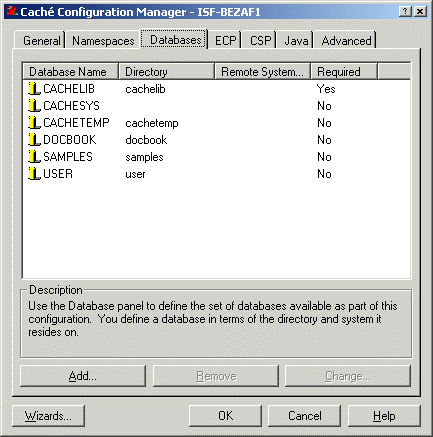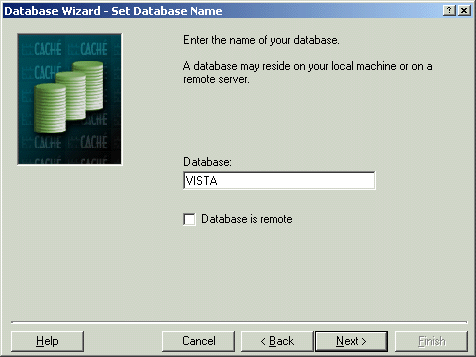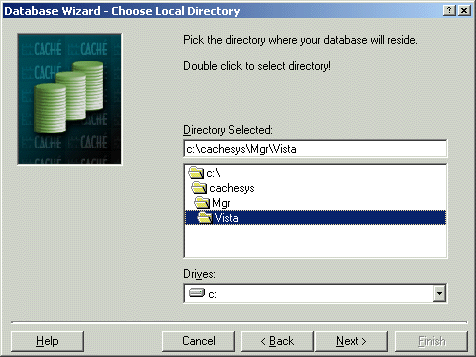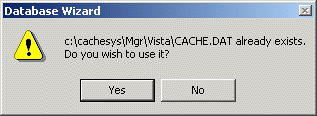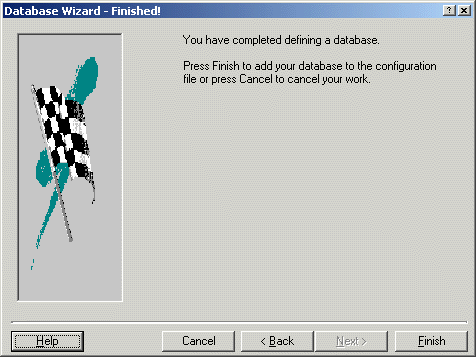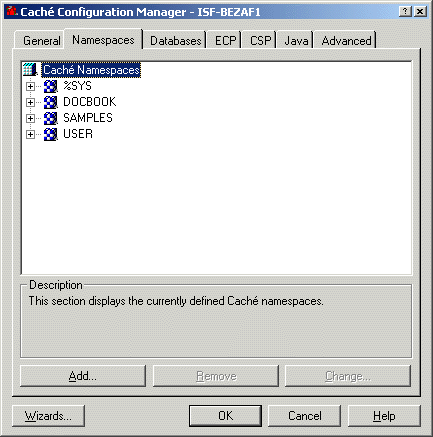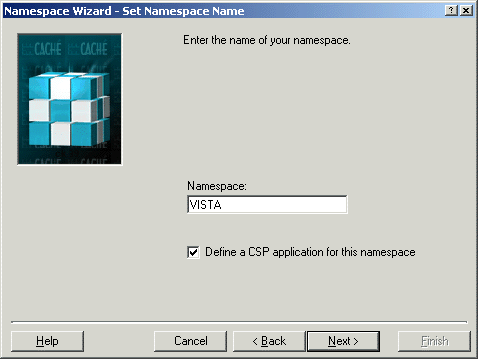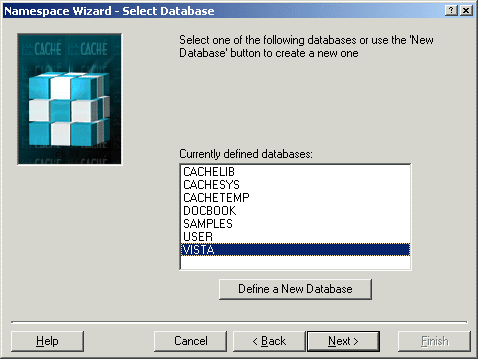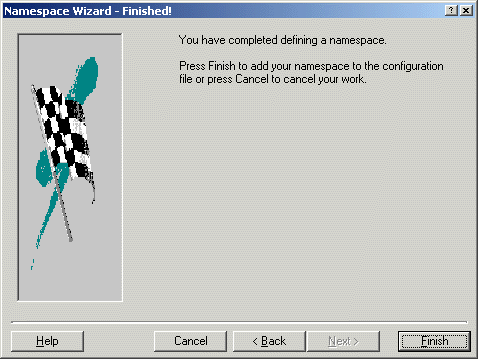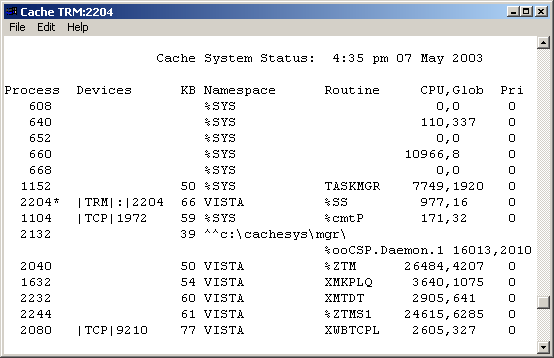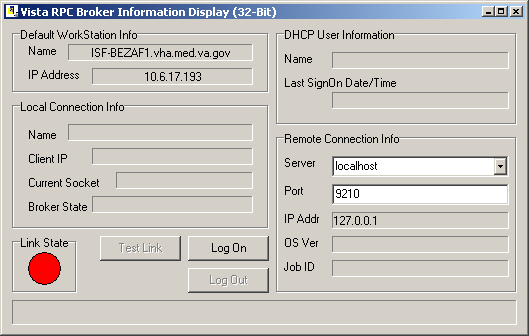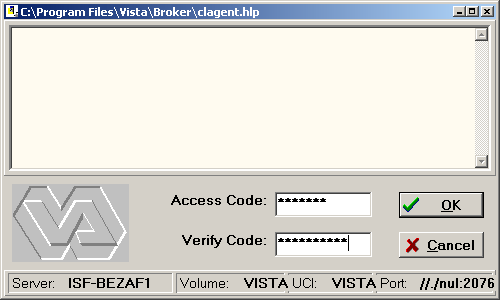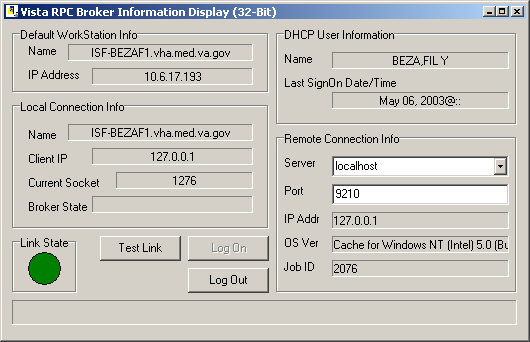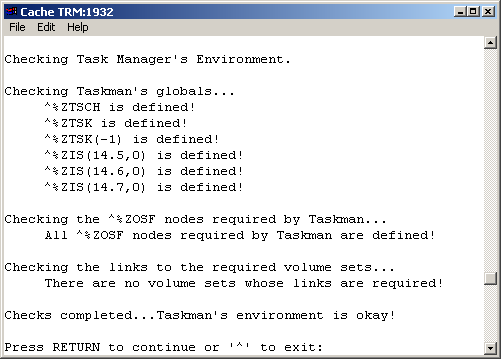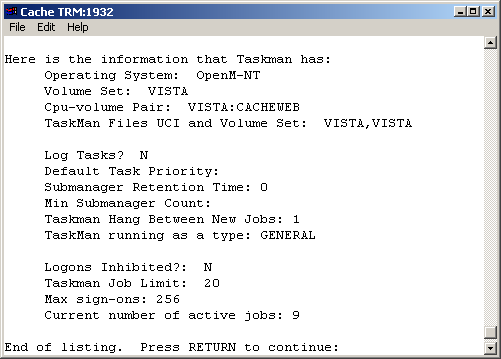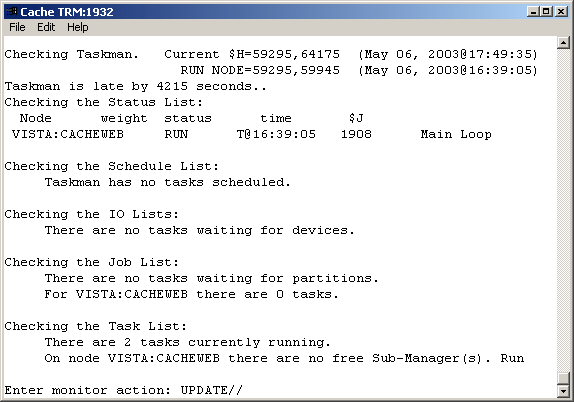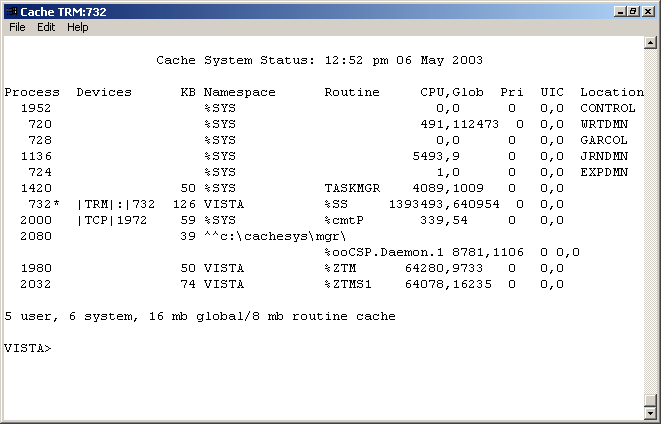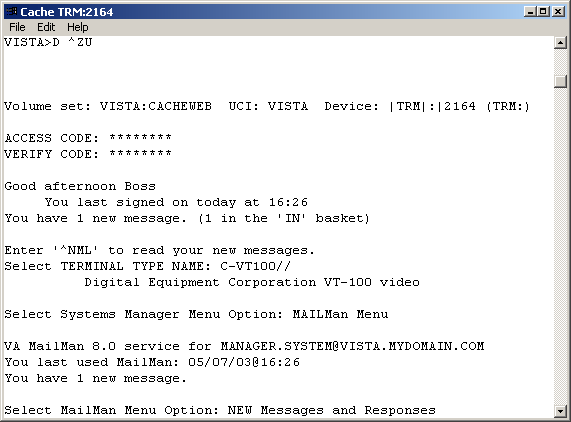|
|
| Line 170: |
Line 170: |
| | <tr><td colspan="2"> </td></tr> | | <tr><td colspan="2"> </td></tr> |
| | | | |
| | + | <tr> |
| | | | |
| − | <h4>Mapping Globals and Routines to Datasets</h4> | + | </table> |
| − | <h5>Globals are persistent M data structures where files and data are stored and routines are M programs. Mapping is a way to tell Caché where to look for globals and routines. By default, Caché maps routines and globals that start with the "%" character to a namespace separate from the routines and globals that do not start with the "%" character. With VistA, it is recommended that all VistA routines and globals that start with the character "%" be mapped to the same namespace as non-% routines and globals overriding the Caché default. The primary reason for this is to preserve these VistA globals and routines when Caché is upgraded to a new version.</h5>
| + | <table> |
| − | | + | ==Mapping Globals and Routines to Datasets== |
| − | | + | Globals are persistent M data structures where files and data are stored and routines are M programs. Mapping is a way to tell Caché where to look for globals and routines. By default, Caché maps routines and globals that start with the "%" character to a namespace separate from the routines and globals that do not start with the "%" character. With VistA, it is recommended that all VistA routines and globals that start with the character "%" be mapped to the same namespace as non-% routines and globals overriding the Caché default. The primary reason for this is to preserve these VistA globals and routines when Caché is upgraded to a new version.</td></tr> |
| | + | </table> |
| | + | <table> |
| | <tr> | | <tr> |
| | <td valign="top" width=25>14.</td> | | <td valign="top" width=25>14.</td> |
See the VistA introduction on the Main Page for important information on basic concepts and terminology that you must be familiar with in order to understand the installation instructions.
The rest of this installation how to will guide you through all of these steps.
The command summary here is used in M to perform various VistA tasks. It is placed in the beginning of the document so you can easily refer to it. You won't understand any of this until you begin installing VistA, so you can skip reading this and go on to the next section.
| 14. |
With the Namespaces tab still selected expand Vista. |
| |
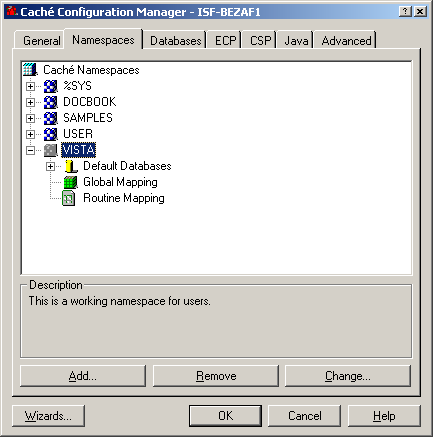 |
| |
| 15. |
Click on Global Mapping then click Add. (Globals are the "persistent" M variables used by VistA, in which the files used by FileMan are stored.) |
| |
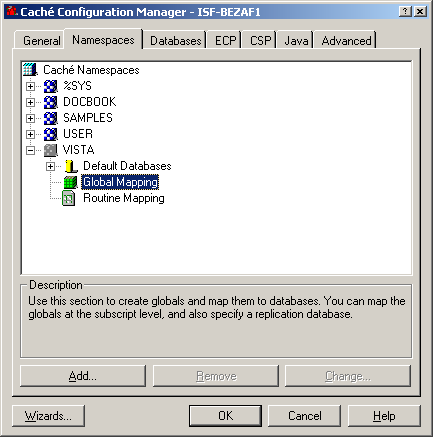 |
| |
| 16. |
Type in "%Z*" in the Enter Global window. (This indicates all variables beginning with %Z as * is a "wild card" or "place holder" for any number of digits/characters, etc., that might follow Z.) |
| 17. |
Click OK. |
| |
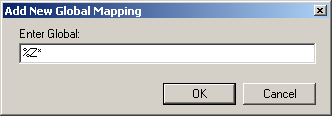 |
| |
| 18. |
Click Routine Mapping then click Add. (Routines are programs written in M) |
| |
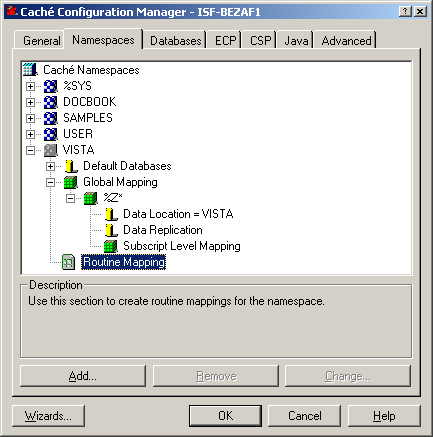 |
| |
| 19. |
Enter "%DT*" in the Enter Routine window then click OK. |
| |
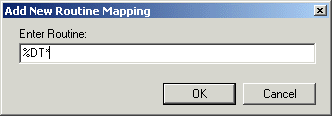 |
| |
| 20. |
Repeat the same thing for Routine Mapping for: %RCR, %XU*, %ZIS*, %ZO*, %ZT*, %ZV*. |
| |
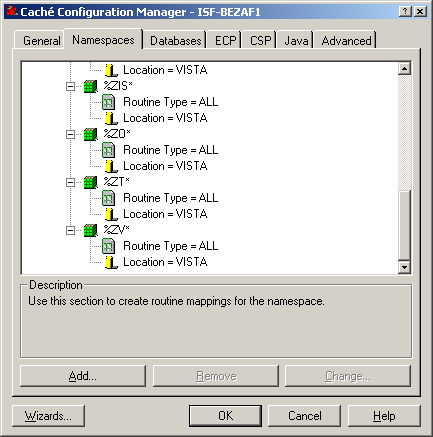 |
| |
| 21. |
When you are finished, click OK. |
| 22. |
Click Activate. |
| |
 |
| |
| 23. |
Right click the Caché Cube and choose Explorer. |
| 24. |
On the left panel, expand the VISTA Folder. |
| 25. |
Click on Globals and be sure lots of globals are listed (about 300) in alphabetical order. ABS was the first global and YTX was the last. |
| |
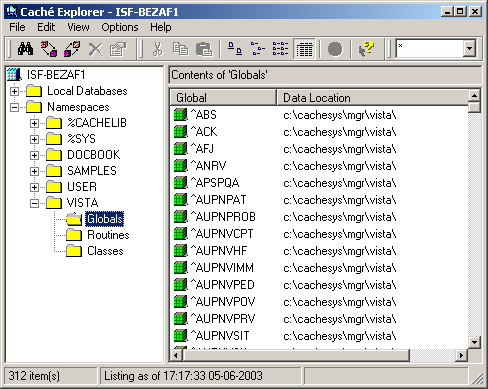 |
| |
| 26. |
Click Routines and be sure the same thing happens. (Our experience has
been Explorer times out and is automatically closed.) Wait until the
disk is done moving (about 2 minutes) and then re-open explorer and it
should work fine. There should be 20484 routines found.
|
| 27. |
After all the routines are loaded, close Explorer. |
| |
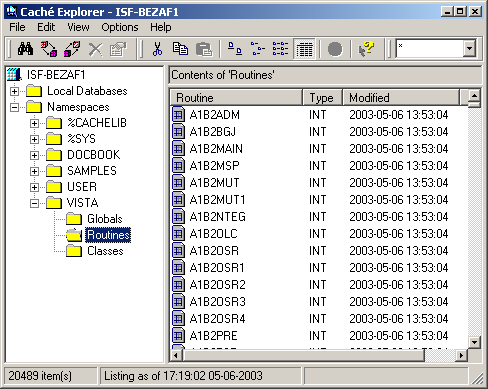 |
| |
Convert the Database from Use in Caché 4 to Caché 5
The distributed FOIA CACHE.DAT was generated with Caché v4. It needs to be converted to be compatible with Caché v5. You will not need to perform this step if you version is compatible with the version used by the VA.
28. |
Right click on the Caché Cube and choose Terminal. |
| 29. |
At User prompt Type D ^%CD (or ZN "%SYS").
|
| 30. |
At Namespace type "%SYS". The remainder of this step converts the database that is run on Caché 4 by the VA to the latest version of Caché, which is 5 at the time of this writing. Once the VA source of the Platinum install switches over to Caché 5, it will not be necessary, but it should not hurt anything to run it. Enter "DO ALL^%SYSCONV". You must allow this to finish. You should have the following output: |
| |
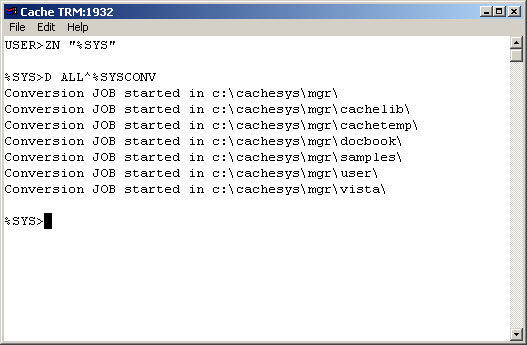 |
| |
| 31. |
Next you check the success of the conversion. Type "DO STATUS^%SYSCONV" to see the status of the conversion. You should see something like that shown below. If you see RECOMPILE In Progress anywhere, wait and let it complete. You can check if it is completed by running "D STATUS^%SYSCONV" again until the recompile is done. Use the up arrow on your keyboard to go back one step to make it easy to rerun D STATUS^%SYSCONV. (Note in M, D is short for DO.) If there is an "Error: <FUNCTION>" under C:\Cachesys\mgr\samples\, this is a problem with Caché's samples, not with VistA, so do not be concerned about it for the purpose of installing VistA.
|
| |
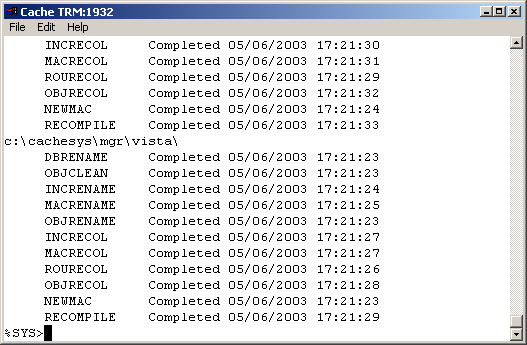 |
| |
Begin to set up the VistA System
The routine ZTMGRSET defines VistA global variables and saves system wide M routines that are Caché specific. FileMan is the database system used by all VistA applications.
| 32. |
At User prompt Type "D ^%CD". |
| 33. |
At Namespace Type "VISTA" (or use ZN "VISTA"). |
| 34. |
Type in "D ^ZTMGRSET". It will respond with a few lines ending with either I think it is VISTA,CACHEWEB. Should I continue anyway? N// or I think it is VISTA,VISTA. Should I continue anyway? N// and you should type "Y". It will respond I think you are using OpenM-NT. Which MUMPS system should I install? Choose 3. |
| |
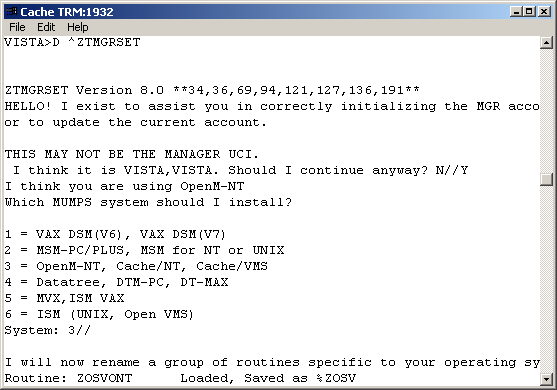 |
| |
| 35. |
Several lines later you will be presented with: (Note: VistA presents a default response followed by "//" as in VISTA// below. Pressing Enter accepts the default.) |
| |
| |
NAME OF MANAGER'S NAMESPACE: VISTA// Hit enter.
PRODUCTION (SIGN-ON) NAMESPACE: VISTA// Hit enter.
NAME OF THIS CONFIGURATION: VISTA// Hit enter.
|
| |
| |
You will have several lines of routines loading finishing with:
|
| |
| |
Installing ^%Z editor
Setting ^%ZIS('C')
Now, I will check your % globals....
ALL DONE.
|
| 36. |
Initialize FileMan to set your site name and number by running "D ^DINIT" from the VISTA> prompt. Say yes to Intilialize VA Fileman if it isn't already initialized. Give your site a site name and a 4 digit site number that is preferably not a round number like 1000 or 5000 so you have less chance of file number collisions when you make your own files in the future. You can run D ^DINIT again to see if you changes were successful and choose Cache/OpenM when offered a choice of MUMPS system you are using. |
| 37. |
If you have the latest version of Caché with CacheWeb, you will need to edit the routine ^%ZOSV. To do this, right click the Caché Cube and choose Studio, File, Change Namespace, select VISTA then click OK. |
| |
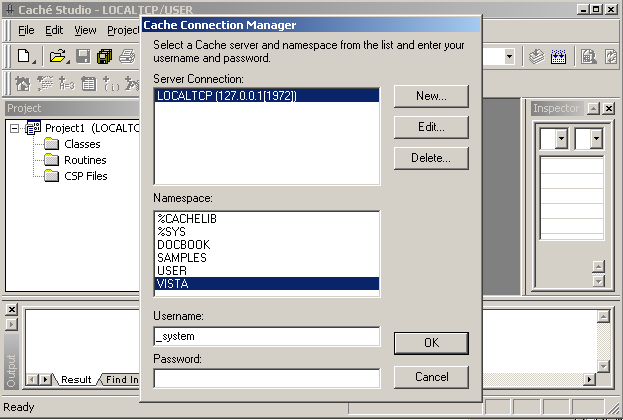
|
| 38. |
This step may not be needed in newer versions of VistA, but check anyway. Highlight LOCALTCP-VISTA, then File, Open and enter "%ZOSV.INT". Open it and see if the first several lines are as follows: |
| |
%ZOSV ;SFISC/AC - $View commands for Open M for NT. ;12/04/2001 15:30
;;8.0;KERNEL;**34,94,107,118,136,215**;Jul 10, 1995
ACTJ() ;# Active jobs
N Y,% S %=0 F Y=0:1 S %=$ZJ(%) Q:%=""
Q Y
AVJ() ;# available jobs
;Return fixed value if version < 2.1.6 (e.i. not Caché)
|
| |
If the lines are as above, after the line |
| |
;Return fixed value if version < 2.1.6 (e.i. not Cache) |
| |
Insert |
| |
Q 99 ;Dummy return for Cache 5 |
| |
|
Now if you made changes, click File, Save and then Build, Compile. At the bottom of the window you should soon see the message "Compilation finished successfully." |
| |
| 39. |
In a similar fashion, check to see if you need to edit the XWBTCPC.INT routine by inserting 'W:XWBOS="OpenM"&(+$$VERSION^%ZOSV()'<5) ! ' after 'I $L(STR)<511 W:($X+$L(STR))>511 ! W STR ', as shown below. This step may also not be necessary in newer versions of VistA. |
| |
Original line looks like: |
| |
I $L(STR)<511 W:($X+$L(STR))>511 ! W STR Q |
| |
New line looks like: |
| |
I $L(STR)<511 W:($X+$L(STR))>511 ! W STR W:XWBOS="OpenM"&(+$$VERSION^%ZOSV()'<5) ! Q |
| |
| |
***N.B. For those interested, this is an excerpt from the hardhats mailing list describing the reason for this step: |
| |
| |
If you run an RPCBroker application, server opens a new session with
XWBTCPC routine for the client but it does not return what it should for
the XUS SIGNON SETUP (volume set, namespace, device, ...)
Server is hanging in READ command in XWBTCPC and waiting for a new message
from the client. And client is still waiting for the return message for
XUS SIGNON SETUP remote procedure.
The reason was that server doesn't always flush the buffer without an '!'
after WRITE command. This makes problems when returning data for remote
procedures which type is ARRAY or GLOBAL ARRAY.
I made it work by adding an '!' after WRITE in WRITE+4 label in XWBTCPC routine:
;I $L(STR)<511 W:($X+$L(STR))>511 ! W STR Q ; the original line
I $L(STR)<511 W:($X+$L(STR))>511 ! W STR W:XWBOS="OpenM"&(+$$VERSION^%ZOSV()'<5) ! Q |
| |
|
This step will almost certainly be necessary to avoid getting a message telling you the maximum number of users are now logged in. Edit XUS.INT after the SET2 "tag", commenting out the line I $D(^%ZOSF("ACTJ")) X ^("ACTJ") I $P(XUVOL,U,3),($P(XUVOL,U,3)'>Y) Q 2 with a semicolon as shown below. |
| |
| |
SET2() ;EF. Return error code
S XUNOW=$$HTFM^XLFDT($H),DT=$E(XUNOW,1,7)
S X=$P(XOPT,U,14) I "N"'[X S XUF=(X["R")+1,XUF(.1)="",XUF(.2)=0,XUF(.3)=0 I X["D" S:$D(^XTV(8989.3,1,4.33,"B",XUDEV))[0 XUF=0
K DUZ,XUSER S (DUZ,DUZ(2))=0,(DUZ(0),DUZ("AG"),XUSER(0),XUSER(1),XUTT,%UCI)=""
I $G(^%ZIS(14.5,"LOGON",XQVOL)) Q 1
; I $D(^%ZOSF("ACTJ")) X ^("ACTJ") I $P(XUVOL,U,3),($P(XUVOL,U,3)'>Y) Q 2
S X=$G(^%ZIS(1,XUDEV,"XUS")),XU1=$G(^(1)) F I=1:1:15 I $P(X,U,I)]"" S $P(XOPT,U,I)=$P(X,U,I)
S DTIME=600
I '$P(XOPT,U,11),$D(^%ZIS(1,XUDEV,90)),^(90)>2800000,^(90)'>DT Q 8
I $D(XRT0) S XRTN="XUS" D T1^%ZOSV Q
|
| |
|
Don't forget to save and compile any routines you change. |
| |
| 40. |
CLOSE Studio and go back to Terminal and run "D ^%CD" and enter "VISTA" for the namespace again. |
| |
|
Now determine the what is called the "BOX:VOLUME pair", which is really a VOLUME:BOX pair, for your machine. This is done as follows:
|
|
|
VISTA>D GETENV^%ZOSV W Y |
| |
|
Here is a sample return:
|
| |
|
VISTA^CACHE^ANTHRAX^CACHE:CACHEWEB |
| |
|
In this instance, the 4th "piece", assuming ^ is the divider, is CACHE:CACHEWEB, which is the BOX:VOLUME pair. ANTHRAX is the name of the computer this was done on, also known as the NODE. The first CACHE (second "piece") listed is the VOLUME. VISTA is the UCI (also the directory name where CACHE.DAT is located). UCI is an old terminology you do not need to understand, but it helps to know what the UCI should be. The so called BOX:VOLUME pair is actually the VOLUME:BOX pair, but it is always referred to as the "BOX VOLUME pair". In short, this is what the above line corresponds to: |
| |
|
UCI^VOL^NODE^BOX:VOLUME |
| |
|
Jot down your BOX:VOLUME pair for comparison with what you find as the installation continues to be sure it has been set correctly. It is very important that it be correct in some of the parameter files. |
| |
| 41. |
Now to create your own domain. From the VISTA prompt, start VA FileMan by typing "D Q^DI". At the Select OPTION: prompt. Type "1". (You can see why you typed 1 if you type "??" at the option prompt. That will give you the list of options you can choose from and 1 is ENTER OR EDIT FILE ENTRIES.) At INPUT TO WHAT FILE: type "DOMAIN" and accept the ALL// default to EDIT WHICH FIELD. At Select DOMAIN NAME: enter a local domain name. Substitute an appropriate value for VISTA.MYDOMAIN.COM in the example below.
N.B. If you are prompted for an ACCESS CODE, you will need to skip ahead to the section "Set Yourself Up as the System Manager", steps 49-78, and do that first. Then return to this step and use the ACCESS CODE you gave the System Manager. |
| |
| |
Select OPTION: 1 ENTER OR EDIT FILE ENTRIES
INPUT TO WHAT FILE: NEW PERSON// DOMAIN
EDIT WHICH FIELD: ALL//
Select DOMAIN NAME: VISTA.MYDOMAIN.COM
Are you adding 'VISTA.MYDOMAIN.COM' as
a new DOMAIN (the 2ND)? No// Y (Yes)
FLAGS: ^
Select DOMAIN NAME:
|
| |
| 42. |
Now to complete the DOMAIN set up by Christening the new domain. Go back to the VISTA> prompt and type "D CHRISTEN^XMUDCHR". |
| |
| |
VISTA>DO CHRISTEN^XMUDCHR
* * * * WARNING * * * *
You are about to change the domain name of this facility
in the MailMan Site Parameters file.
Currently, this facility is named: PLATINUM.VISTA.MED.VA.GOV
You must be extremely sure before you proceed!
Are you sure you want to change the name of this facility? NO// YES
Select DOMAIN NAME: PLATINUM.VISTA.MED.VA.GOV// VISTA.MYDOMAIN.COM
The domain name for this facility is now: VISTA.MYDOMAIN.COM
PARENT: 4// PLATINUM.VISTA.MED.VA.GOV
TIME ZONE: MDT// PDT PACIFIC DAYLIGHT
PLATINUM.VISTA.MED.VA.GOV has been initialized as your 'parent'
domain.
(Forum is usually the parent domain, unless this is a subordinate domain.)
You may edit the MailMan Site Parameter file to change your parent domain.
We will not initialize your transmission scripts.
Use the 'Subroutine editor' option under network management menu to add your
site passwords to the MINIENGINE script, and the 'Edit a script' option
to edit any domain scripts that you choose to.
|
| |
| 43. |
Determine the internal entry of the new domain. Remember this number as it will be used in subsequent steps. Get back to the Select OPTION: prompt and enter "INQUIRE" or "5" (once again, you can type ?? to see the available options and 5 is INQUIRE TO FILE ENTRIES) then at the Select DOMAIN NAME: prompt, enter the new domain name you just created. Answer "N" to STANDARD CAPTIONED OUTPUT and at PRINT FIELD: answer "NUMBER". The domain number is "printed" to the screen.
|
| |
| |
Select OPTION: 5 INQUIRE TO FILE ENTRIES
OUTPUT FROM WHAT FILE: DOMAIN//
Select DOMAIN NAME: VISTA.MYDOMAIN.COM
ANOTHER ONE:
STANDARD CAPTIONED OUTPUT? Yes// N (No)
FIRST PRINT FIELD: NUMBER
THEN PRINT FIELD:
Heading (S/C): DOMAIN LIST//
DEVICE: CONSOLE Right Margin: 80//
DOMAIN LIST APR 11,2003 10:51 PAGE 1
NUMBER
3
|
| |
| 44. |
From the VISTA prompt repoint the KERNEL SYSTEM PARAMETERS and RPC BROKER PARAMETERS files to the new domain, go back to the VISTA> prompt and enter 'S $P(^XTV(8989.3,1,0),"^")=3' and 'S $P(^XWB(8994.1,1,0),"^")=3' where 3 is the internal number of the new domain we just created in the previous step. |
| |
| |
VISTA>S $P(^XTV(8989.3,1,0),"^")=3
VISTA>S $P(^XWB(8994.1,1,0),"^")=3
|
| |
| 45. |
Then from the VISTA> prompt again start FileMan with "D Q^DI". At Select OPTION: enter "6" (UTILITY FUNCTIONS) then select RE-INDEX FILE. At MODIFY WHAT FILE, enter "KERNEL SYSTEM PARAMETERS". Then do the same for the RPC BROKER PARAMETERS file. See example below for the rest of the dialogue.
|
| |
| |
VISTA>D Q^DI
VA FileMan 22.0
Select OPTION: UTILITY FUNCTIONS
Select UTILITY OPTION: RE-INDEX FILE
MODIFY WHAT FILE: DOMAIN// 8989.3 KERNEL SYSTEM PARAMETERS (1 entry)
THERE ARE 13 INDICES WITHIN THIS FILE
DO YOU WISH TO RE-CROSS-REFERENCE ONE PARTICULAR INDEX? No// (No)
OK, ARE YOU SURE YOU WANT TO KILL OFF THE EXISTING 13 INDICES? No// Y (Yes)
DO YOU THEN WANT TO 'RE-CROSS-REFERENCE'? Yes// (Yes)
...EXCUSE ME, LET ME THINK ABOUT THAT A MOMENT...
FILE WILL NOW BE 'RE-CROSS-REFERENCED'................
Select UTILITY OPTION: RE-INDEX FILE
MODIFY WHAT FILE: KERNEL SYSTEM PARAMETERS// 8994.1 RPC BROKER SITE PARAMETERS (1 entry)
THERE ARE 5 INDICES WITHIN THIS FILE
DO YOU WISH TO RE-CROSS-REFERENCE ONE PARTICULAR INDEX? No// (No)
OK, ARE YOU SURE YOU WANT TO KILL OFF THE EXISTING 5 INDICES? No// Y (Yes)
DO YOU THEN WANT TO 'RE-CROSS-REFERENCE'? Yes// (Yes)
...HMMM, HOLD ON...
FILE WILL NOW BE 'RE-CROSS-REFERENCED'......
|
| |
| 46. |
Check the VOLUME SET File (#14.5). If you accepted the default VISTA when you ran ZTMGRSET (<a href="#ZTMGRSET">see previous steps</a>), the VOLUME SET File should not need any changes. At Select OPTION: enter "1" for EDIT OR ENTER FILE ENTRIES. The choice should be INPUT TO WHAT FILE: VOLUME SET//. Accept the default if it is VOLUME SET else type "14.5", and at EDIT WHICH FIELD: ALL// hit enter. At Select VOLUME SET prompt type "??" to see a list of entries. When asked which volume set again, type in VISTA or whatever it is exactly as it is (all caps). Leave TASKMAN FILES UCI: VISTA// as VISTA. The values should match what is shown below.
|
| |
| |
Select OPTION: 1 ENTER OR EDIT FILE ENTRIES
INPUT TO WHAT FILE: VOLUME SET// 14.5 VOLUME SET (1 entry)
EDIT WHICH FIELD: ALL//
Select VOLUME SET: ??
VISTA
You may enter a new VOLUME SET, if you wish
Answer should be the name of a volume set.
When each cpu can have only one volume set, this is also the cpu name.
Answer will be used in extended global references to reach this volume.
Select VOLUME SET: VISTA
VOLUME SET: VISTA//
TYPE: GENERAL PURPOSE VOLUME SET//
INHIBIT LOGONS?: NO//
LINK ACCESS?: YES//
OUT OF SERVICE?: NO//
REQUIRED VOLUME SET?: NO//
TASKMAN FILES UCI: VISTA//
TASKMAN FILES VOLUME SET: VISTA//
REPLACEMENT VOLUME SET:
DAYS TO KEEP OLD TASKS: 4//
SIGNON/PRODUCTION VOLUME SET: Yes//
Select VOLUME SET:
|
| |
| 47. |
This step is to get the proper value for the BOX-VOLUME PAIR in the TASKMAN SITE PARAMETERS File. Edit the TASKMAN SITE PARAMETER File (# 14.7) to update the BOX-VOLUME PAIR. Note that when you enter a "?" at the BOX-VOLUME PAIR prompt, it tells you what the correct value should be.
|
| |
| |
Select OPTION: 1 ENTER OR EDIT FILE ENTRIES
INPUT TO WHAT FILE: VOLUME SET// 14.7 TASKMAN SITE PARAMETERS
(1 entry)
EDIT WHICH FIELD: ALL//
Select TASKMAN SITE PARAMETERS BOX-VOLUME PAIR: ?
Answer with TASKMAN SITE PARAMETERS BOX-VOLUME PAIR:
VISTA:CACHE
You may enter a new TASKMAN SITE PARAMETERS, if you wish
Answer must be 3-30 characters in length.
The value for the current account is VISTA:CACHEWEB
Select TASKMAN SITE PARAMETERS BOX-VOLUME PAIR: VISTA:CACHE
BOX-VOLUME PAIR: VISTA:CACHE// VISTA:CACHEWEB
RESERVED: ^
Select TASKMAN SITE PARAMETERS BOX-VOLUME PAIR:
|
| |
| 48. |
Now update the RPC BROKER SITE PARAMETER File. |
| |
| |
Select OPTION: 1 ENTER OR EDIT FILE ENTRIES
INPUT TO WHAT FILE: TASKMAN SITE PARAMETERS// 8994.1 RPC BROKER SITE PARAMETERS
EDIT WHICH FIELD: ALL//
Select RPC BROKER SITE PARAMETERS DOMAIN NAME: VISTA.MYDOMAIN.COM
...OK? Yes// (Yes)
DOMAIN NAME: VISTA.MYDOMAIN.COM//
Select BOX-VOLUME PAIR: VISTA:CACHEWEB//
BOX-VOLUME PAIR: VISTA:CACHEWEB//
Select PORT: 9210//
PORT: 9210//
*UCI:
STATUS: STOPPED//
CONTROLLED BY LISTENER STARTER: YES// N NO
|
| |
| 49. |
Now to set up the System Manager user with minimal information. We will add more information later. At Select OPTION: Type "1" (Type "??" to see Option 1 if you wish) |
| 50. |
At INPUT TO WHAT FILE: Type "200", the number of the NEW PERSON file.
|
| 51. |
At EDIT WHICH FIELD: ALL// Type ".01" and hit enter. It will echo back NAME. |
| 52. |
It may respond with finish with NEW PERSON, 2 ENTRIES and then prompt you. |
| 53. |
At THEN EDIT FIELD: Type "ACCESS CODE" and the computer will finish it with Want to edit access code (Y/N)? Hit Enter and hit enter until you are prompted with Select NEW PERSON NAME.
|
| 54. |
At Select NEW PERSON NAME, Type "MANAGER,SYSTEM" or whatever you choose. |
| 55. |
At Are you adding "MANAGER,SYSTEM" as a NEW PERSON (the 2nd [or whatever it offers you])? No// type "Y".
|
| 56. |
It will respond Checking SOUNDEX for matches. No matches found. NEW PERSON INITIAL:
|
| 57. |
Type "SM" or whatever you choose.
|
| 58. |
At Want to Edit ACCESS Code (Y/N): Type "Y". For NEW PERSON MAIL CODE: hit ENTER.
|
| 59. |
Then enter an access code. (Type "??" and hit enter to see what the options are for access codes if you wish.) At least 6 mixed alphanumeric characters. If not, just type the code and hit enter.
|
| 60. |
Retype the code as directed. FileMan will respond OK, Access code has been changed! The VERIFY CODE has been deleted as a security measure. The user will have to enter a new one the next time they sign-on.
|
| 61. |
At Select NEW PERSON NAME: Hit enter.
|
| |
| |
Select OPTION: 1 ENTER OR EDIT FILE ENTRIES
INPUT TO WHAT FILE: RPC BROKER PARAMETERS// 200 NEW PERSON
(2 entries)
EDIT WHICH FIELD: ALL// .01 NAME
THEN EDIT FIELD: ACCESS CODE Want to edit ACCESS CODE (Y/N)
THEN EDIT FIELD:
Select NEW PERSON NAME: MANAGER,SYSTEM
Are you adding 'MANAGER,SYSTEM' as a new NEW PERSON (the 3RD)? No// Y (Yes)
Checking SOUNDEX for matches.
No matches found.
NEW PERSON INITIAL: SM
NEW PERSON MAIL CODE:
Want to edit ACCESS CODE (Y/N): Y
Enter a new ACCESS CODE <Hidden>: ******
Please re-type the new code to show that I have it right: ******
OK, Access code has been changed!
The VERIFY CODE has been deleted as a security measure.
The user will have to enter a new one the next time they sign-on.
Select NEW PERSON NAME:
|
| |
| 62. |
At the Select OPTION: prompt Type "5".
|
| 63. |
At OUTPUT FROM WHAT FILE: NEW PERSON// Hit Enter.
|
| 64. |
At Select NEW PERSON NAME: Type "MANAGER,SYSTEM", or whatever you chose for the system manager name and hit enter.
|
| 65. |
At ANOTHER ONE: Hit enter.
|
| 66. |
At STANDARD CAPTIONED OUTPUT? YES// Hit enter or "Y".
|
| 67. |
At Include COMPUTED fields: (N/Y/R/B): NO// type "B".
|
| 68. |
The response will be a screen full of data. At the upper left hand corner will be NUMBER: followed by a number. This number will be the DUZ number that will be used in what follows below.
|
| 69. |
Hit Enter until you back out to VISTA>.
|
| 70. |
At VISTA> Type "SET DUZ= " and after the = sign, type in that number you found above for your DUZ number, and hit Enter.
|
| 71. |
At the next VISTA> prompt, type S $P(^VA(200,DUZ,0),"^",4)="@". This will identify this user as a programmer to VA FileMan.
|
| 72. |
At the next VISTA> prompt, type "D ^XUP". This is the VA Kernel's Programmer entry point.
|
| 73. |
The first time, you will be asked to select a TERMINAL TYPE NAME:. Enter "C-VT100" and select 1.
|
| 74. |
At Select OPTION NAME: Type "XUMAINT", it will echo back Menu Management.
|
| 75. |
At Select Menu Management Option: type "KEY" Management; then at Select Key Management Option: "ALLO"cation of Security Keys.
|
| 76. |
Proceed to allocate the following keys - XUMGR, XMMGR, XUPROG, XUPROGMODE.
|
| 77. |
When it asks Holder of the key, enter "MANAGER,SYSTEM" or whatever name you selected.
|
| |
| |
VISTA>S DUZ=1
VISTA>S $P(^VA(200,DUZ,0),"^",4)="@"
VISTA>D ^XUP
Setting up programmer environment
Select TERMINAL TYPE NAME: C-VT100
1 C-VT100 Digital Equipment Corporation VT-100 video
2 C-VT100HIGH Normal display of characters in BOLD !
CHOOSE 1-2: 1 C-VT100 Digital Equipment Corporation VT-100 video
Terminal Type set to: C-VT100
Select OPTION NAME: XUMAINT Menu Management
Select Menu Management Option: KEY Management
Select Key Management Option: ALLOcation of Security Keys
Allocate key: XUMGR
Another key: XUPROG
1 XUPROG
2 XUPROGMODE
CHOOSE 1-2: 1 XUPROG
Another key: XUPROGMODE
Another key: XMMGR
Another key:
Holder of key: MANAGER,SYSTEM SM
Another holder:
You've selected the following keys:
XUPROG XUMGR XUPROGMODE XMMGR
You've selected the following holders:
MANAGER,SYSTEM
You are allocating keys. Do you wish to proceed? YES//
XUPROG being assigned to:
MANAGER,SYSTEM
XUMGR being assigned to:
MANAGER,SYSTEM
XUPROGMODE being assigned to:
MANAGER,SYSTEM
XMMGR being assigned to:
MANAGER,SYSTEM
Select Key Management Option:
|
| |
| 78. |
If you are planning to use the VistA applications such as Registration, Scheduling etc. you need to add new Institution to the INSTITUTION File. Go back to the VISTA> prompt and "SET XUMF=1" then "D Q^DI". Select Option #1 and edit File #4. Edit the field STATION NUMBER. For Station Number, you must enter the same number as the Site Number when you initialized FileMan. (See Start FileMan and <a href="#Vista_Setup">Begin Setting Up Vista section</a>.)
|
| |
| |
VISTA>S XUMF=1 D Q^DI
VA FileMan 22.0
Select OPTION: 1 ENTER OR EDIT FILE ENTRIES
INPUT TO WHAT FILE: NEW PERSON// 4 INSTITUTION (27 entries)
EDIT WHICH FIELD: ALL// STATION NUMBER
THEN EDIT FIELD:
Select INSTITUTION NAME: VISTA HEALTH CARE
Are you adding 'VISTA HEALTH CARE' as a new INSTITUTION (the 28TH)? No// Y (Yes)
STATION NUMBER: 6100
Select INSTITUTION NAME:
|
| 79. |
Then you need to add a Medical Center Division. Select File #40.8 and edit fields FACILITY NUMBER and INSTITUTION FILE POINTER. Enter the Institution STATION NUMBER for FACILITY NUMBER and the name of the Institution in INSTITUTION FILE POINTER.
|
| |
| |
Select OPTION: 1 ENTER OR EDIT FILE ENTRIES
INPUT TO WHAT FILE: INSTITUTION// 40.8 MEDICAL CENTER DIVISION (1 entry)
EDIT WHICH FIELD: ALL// FACILITY NUMBER
THEN EDIT FIELD: INSTITUTION FILE POINTER
THEN EDIT FIELD:
Select MEDICAL CENTER DIVISION NAME: VISTA MEDICAL CENTER
Are you adding 'VISTA MEDICAL CENTER' as
a new MEDICAL CENTER DIVISION (the 2ND)? No// Y (Yes)
MEDICAL CENTER DIVISION NUM: 2//
MEDICAL CENTER DIVISION FACILITY NUMBER: 6100A
FACILITY NUMBER: 6100A//
INSTITUTION FILE POINTER: VISTA HEALTH CARE 6100
Select MEDICAL CENTER DIVISION NAME:
|
| 80. |
You are now ready to enter additional information for the system manager user like PRIMARY MENU, VERIFY CODE etc.
|
| 81. |
Go back to the VISTA prompt and type "D ^XUP".
|
| 82. |
At Select OPTION NAME: Type "XUSEREDIT", it will give you two choices, select 1.
|
| 83. |
At Select NEW PERSON NAME: Type the name you chose for Manager, System.
|
| |
| |
VISTA>D ^XUP
Setting up programmer environment
Terminal Type set to: C-VT100
Select OPTION NAME: XUSERED
1 XUSEREDIT Edit an Existing User
2 XUSEREDITSELF Edit User Characteristics
CHOOSE 1-2: 1 XUSEREDIT Edit an Existing User
Edit an Existing User
Select NEW PERSON NAME: MANAGER,SYSTEM SM
|
| |
| 84. |
Now you will be presented with a screen with multiple options. You can navigate the screen with the TAB key. For navigation help, use your keyboard arrows to move down to the command line and hold down either the Num Lock key (which is mapped as PF1 of a VT-320 terminal by Caché) or F1 for other terminal emulations and hit "H" and then Enter for help. You can exit by typing "^" on the command line and the change you made will be saved. As a minimum, assign EVE as the PRIMARY MENU and enter IRM (it's the only choice) as SERVICE/SECTION. If you plan to use CPRS, enter OR CPRS GUI CHART as a SECONDARY MENU OPTION. Enter other data as you deem appropriate.
|
| |
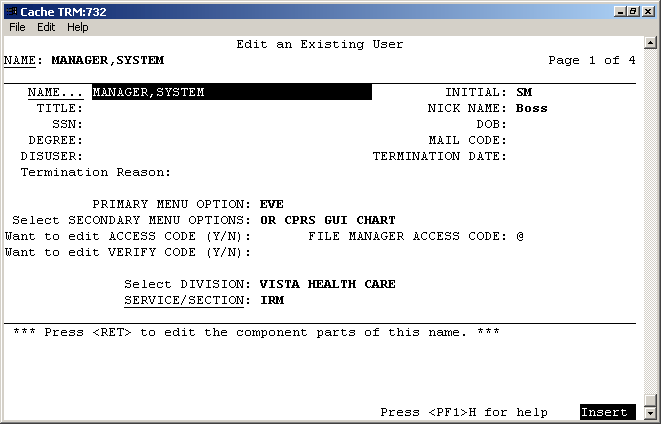 |
| |
| 85. |
Type "N"EXT PAGE at COMMAND: to go to page 2 to update the TIMED READ field and other fields you wish to update. For DEFAULT TIMED-READ (SECONDS): if you change it to 3600 you will be allow an hour before being automatically signed off. It makes it easier to work when you are learning and setting things up.
|
| |
| |
Press <PF1> refers to notations for use of Vista on Terminals. For example, the original VT-320 keyboard had additional character sets and keys which include Find, Select, Insert, Remove, Previous Screen, Next Screen, an arrow cluster and F1 to F20. With Caché, the Keys are "mapped", which means when you push a given key it acts as the key would in a terminal. For instance, F1, F2, F3 and F4 are equivalent to the PF1, PF2, PF3 and PF4 keys on the terminal keyboard and Page Up and Page Down on the computer keyboard correspond to Previous Screen and Next Screen. A listing of other mappings can be found at the Caché Cube Terminal window under Help and search Keyboard Mappings. Also there is lots of information about terminal if you are interested at <a href="http://www.VT100.net">www.VT100.net</a>.
|
| |
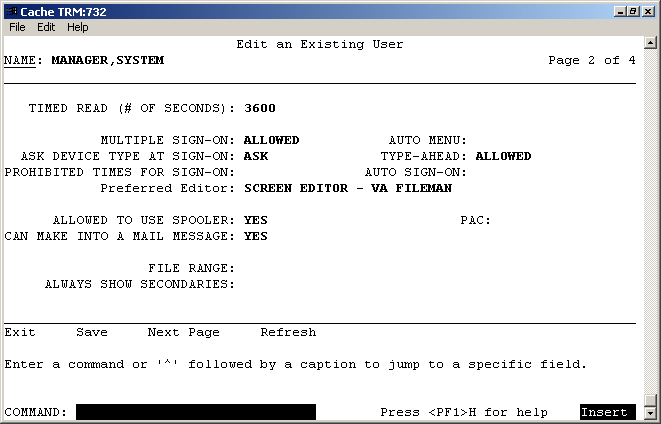 |
| |
| 86. |
The next step is to make FileMan, MailMan, and Manage MailMan menus accessible to the System Manager user from the menu system. From the VISTA prompt, type "D ^XUP". At Select OPTION NAME: enter "XUMAINT". Then at Select Menu Management, type "EDIT OPTIONS", then pick EVE.
|
| 87. |
Select 1 from the list then at NAME: EVE// type "^10".
|
| 88. |
At Select ITEM: enter "DIUSER". Hit enter until you get to Select ITEM again (you may enter data for the other fields like SYNONYM if you wish).
|
| 89. |
At the next Select ITEM: enter "XMMGR".
|
| |
| |
VISTA>D ^XUP
Setting up programmer environment
Terminal Type set to: C-VT10
Select OPTION NAME: XUMAINT Menu Management
Select Menu Management Option: EDit options
Select OPTION to edit: EVE
1 EVE Systems Manager Menu
2 EVENT CAPTURE (ECS) EXTRACT AU ECX ECS SOURCE AUDIT Event Capture (ECS) Extract Audit
3 EVENT CAPTURE DATA ENTRY ECENTER Event Capture Data Entry
4 EVENT CAPTURE EXTRACT ECXEC Event Capture Extract
5 EVENT CAPTURE MANAGEMENT MENU ECMGR Event Capture Management Menu
Press <RETURN> to see more, '^' to exit this list, OR
CHOOSE 1-5: 1 EVE Systems Manager Menu
NAME: EVE// ^10 MENU
Select ITEM: HL MAIN MENU// DIUSER VA FileMan
Are you adding 'DIUSER' as a new MENU (the 13TH for this OPTION)? No// Y (Yes)
MENU SYNONYM: FM
SYNONYM: FM//
DISPLAY ORDER:
Select ITEM: XMMGR
1 XMMGR Manage Mailman
2 XMMGR-BACKGROUND-FILER Background Filer (XMAD)
3 XMMGR-BKFILER-ACT Active Users/Deliveries Report
4 XMMGR-BKFILER-EDIT-NORMALIZED Edit numbers to Normalize
Reports
5 XMMGR-BKFILER-GROUP Deliveries by Group
Press <RETURN> to see more, '^' to exit this list, OR
CHOOSE 1-5: 1 XMMGR Manage Mailman
Are you adding 'XMMGR' as a new MENU (the 14TH for this OPTION)? No// Y (Yes)
MENU SYNONYM:
SYNONYM:
DISPLAY ORDER:
Select ITEM:
CREATOR: MANAGER,SYSTEM// ^
|
| |
| 90. |
Exit by entering "^" at any prompt. At the next Select OPTION to edit: enter "XUCOMMAND". Then at NAME: XUCOMMAND// type "^10". At Select ITEM: enter "XMUSER".
|
| |
| |
Select OPTION to edit: XUCOMMAND SYSTEM COMMAND OPTIONS
NAME: XUCOMMAND// ^10 MENU
Select ITEM: XQALERT// XMUSER MailMan Menu
Are you adding 'XMUSER' as a new MENU (the 8TH for this OPTION)? No// Y (Yes)
MENU SYNONYM: MM
SYNONYM: MM//
DISPLAY ORDER:
Select ITEM:
CREATOR: MANAGER,SYSTEM// ^
Select OPTION to edit:
|
| |
| 91. |
To change the default time it takes before users are automatically signed off the system from the default of 300 seconds. This, again, is to give you more time to work as you are learning. Back out to the VISTA prompt. At the VISTA prompt, Type "D ^ZU".
|
| 92. |
At ACCESS CODE, type in the code you chose when setting up MANAGER, SYSTEM as a NEW PERSON.
|
| 93. |
At VERIFY CODE, hit ENTER. When asked for a new verify code, type the code you choose and remember it.
|
| 94. |
At Select Systems Manager Menu Option: Type "OPER", (short for operations management) and hit enter. You can see all of the choices available to you if you type "??". |
| 95. |
At Select Operations Management Option: Type "KER" short for Kernel Management Menu and hit enter. At Select Kernel Management Menu Option: Type "ENT", short for Enter/Edit Kernel Site Parameters. Hit enter.
|
| 96. |
You will be presented with a similar screen as in editing the SYSTEM MANAGER characteristics. You can navigate the screen with the TAB key. For DEFAULT TIMED-READ (SECONDS): change it to 3600 to allow an hour before being automatically signed off, or whatever you choose.
|
| |
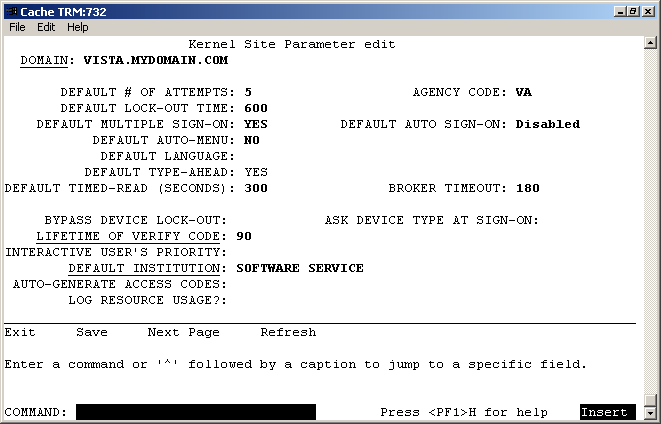 |
| |
Thank you to everyone.
